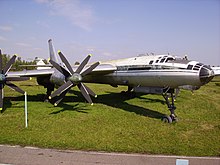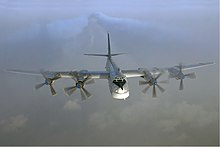Tupolev Tu-95
The Tupolev Tu-95 (Russian: Туполев Ту–95; NATO reporting name: Bear) is a large, four-engine turboprop-powered strategic bomber and missile platform. First flown in 1952, the Tu-95 entered service with the Soviet Union in 1956 and is expected to serve the Russian Air Force until at least 2040.[1] A naval development of the bomber is designated Tu-142.The aircraft has four Kuznetsov NK-12 engines, developed by the Kuznetsov Design Bureau with participation of Ferdinand Brandner and other captured German engineers, each driving contra-rotating propellers. An airliner variant Tu-114 holds the record as the world's fastest propeller-driven aircraft. Some experimental aircraft were designed for theoretically higher speeds, but none attained or registered them. It also remains the only turboprop-powered strategic bomber in operational use. Its distinctively swept-back wings are at 35°, a very sharp angle by the standards of propeller-driven aircraft, and justified by its operating speeds and altitudes. Its blades, which rotate faster than the speed of sound, according to one media source, make it arguably the noisiest military aircraft on earth,[2] with only the experimental 1950s era Republic XF-84H "Thunderscreech" turboprop powered American fighter design as a likely rival.
Design and development

View of a Tu-95 showing its swept-wing planform
A new requirement was issued to both Tupolev and Myasishchev design bureaus in 1950: the proposed bomber had to have an un-refueled range of 8000 km (4,970 mi) — far enough to threaten key targets in the United States. Other goals included the ability to carry an 11,000 kg (11 ton) load over the target.[citation needed]
The big problem for Tupolev was the engine choice: the Tu-4 showed that piston engines were not powerful enough to fulfill that role, while the fuel-hungry AM-3 jet engines of the proposed T-4 intercontinental jet bomber did not provide adequate range.[3] Turboprops offered more power than piston engines and better range than jets, with a top speed in between.
Tupolev's proposal was selected and Tu-95 development was officially approved by the government on 11 July 1951. It featured four Kuznetsov[4] coupled turboprops fitted with eight-bladed contra-rotating propellers, producing a nominal 8,948 kW (12,000 eshp) power rating. Unlike the advanced engine design, the fuselage was conventional: a mid-wing cantilever monoplane with 35 degrees of sweep, an angle which ensured the main wing spar passed through the fuselage in front of the bomb bay. Retractable tricycle landing gear was fitted, with all three gear strut units retracting rearwards, with the main gear units retracting rearwards into extensions of the inner engine nacelles.[citation needed]
The Tu-95/I, with 2TV-2F engines, first flew 11 November 1952 with test pilot Alexey Perelet at the controls.[5] After six months of test flights this aircraft suffered a propeller gearbox failure and crashed, killing Perelet. The second aircraft, Tu-95/II featured four of the 12,000 ehp Kuznetsov NK-12 turboprops which proved more reliable than the coupled 2TV-2F. After a successful flight testing phase, series production of the Tu-95 started in January 1956.[4]

A Tu-95MS simulating aerial refueling with an Ilyushin Il-78 during the Victory Day Parade in Moscow on 9 May 2008.
Initially the United States Department of Defense evaluated the Tu-95 as having a maximum speed of 644 km/h (400 mph) with a range of 12,500 km (7,800 mi).[6] These numbers had to be revised upward numerous times.
Like its American counterpart, the Boeing B-52 Stratofortress, the Tu-95 has continued to operate in the Russian Air Force while several subsequent iterations of bomber design have come and gone. Part of the reason for this longevity was its suitability, like the B-52, for modification to different missions. Whereas the Tu-95 was originally intended to drop free-falling nuclear weapons, it was subsequently modified to perform a wide range of roles, such as the deployment of cruise missiles, maritime patrol (Tu-142), and even civilian airliner (Tu-114). An AWACS platform (Tu-126) was developed from the Tu-114. An icon of the Cold War, the Tu-95 has served not only as a weapons platform but as a symbol of Soviet and later Russian national prestige.
Tu-116

A Tu-116 preserved at Ulyanovsk Aircraft Museum.
Variants and derivatives
- Tu-95/1: The first prototype powered by Kuznetsov 2TV-2F coupled turboprop engines.
- Tu-95/2: The second prototype powered by Kuznetsov NK-12 turboprops.
- Tu-95/Tu-95M: Basic variant of the long-range strategic bomber and the only model of the aircraft never fitted with a nose refuelling probe. Known to NATO as the Bear-A.
- Tu-95K: Experimental version for air-dropping a MiG-19 SM-20 jet aircraft.
- Tu-95K22: Conversions of the older Bear bombers, reconfigured to carry the Raduga Kh-22 missile and incorporating modern avionics. Known to NATO as the Bear-G.
- Tu-95K/Tu-95KD: Designed to carry the Raduga Kh-20 air-to-surface missile. The Tu-95KD aircraft were the first to be outfitted with nose probes. Known to NATO as the Bear-B.
- Tu-95KM:Modified and upgraded versions of the Tu-95K, most notable for their enhanced reconnaissance systems. These were in turn converted into the Bear G configuration. Known to NATO as the Bear-C.
- Tu-95M-55: Missile carrier.
- Tu-95MR: Bear A modified for photo-reconnaissance and produced for Naval Aviation. Known to NATO as the Bear-E.
- Tu-95MS/Tu-95MS6/Tu-95MS16:– Completely new cruise missile carrier platform based on the Tu-142 airframe. This variant became the launch platform of the Raduga Kh-55 cruise missile. Known to NATO as the Bear-H and was referred to by the U.S. military as a Tu-142 for some time in the 1980s before its true designation became known.
- Tu-95N: Experimental version for air-dropping an RS ramjet powered aircraft.
- Tu-95RTs: Razvedchik Tseleukazatel: Variant of the basic Bear A configuration, redesigned for maritime reconnaissance and targeting as well as electronic intelligence for service in the Soviet Naval Aviation. Known to NATO as the Bear-D.
- Tu-95U Uchebnyy: Trainer: Training variant, modified from surviving Bear As but now all have been retired. Known to NATO as the Bear-T.
- Tu-95V Special carrier aircraft to test-drop the largest thermonuclear weapon ever designed, the Tsar Bomba.
- Tu-96: long-range intercontinental high-altitude strategic bomber prototype, a high-altitude version of the Tupolev Tu-95 aircraft with high-altitude augmented turboprop TV-16 engines and with a new,enlarged area wing. Plant tests of the aircraft were performed with non-high altitude TV-12 engines in 1955–1956.[28]
- Tu-114: Airliner derivative of Tu-95.
- Tu-116: Tu-95 fitted with passenger cabins as a stop-gap while the Tu-114 was being developed. Only two converted.[29]
- Tu-95LAL: Experimental nuclear-powered aircraft project.
- Tu-126: AEW&C derivative of Tu-114, itself derived from the Tu-95.
- Tu-142: Maritime reconnaissance/anti-submarine warfare derivative of Tu-95. Known to NATO as the Bear-F.
General characteristics
- Crew: 6–7; pilot, co pilot, flight engineer, communications system operator, navigator, tail gunner plus sometimes another navigator. [34]
- Length: 46.2 m[35] (151 ft 6 in[35])
- Wingspan: 50.10 m[35] (164 ft 5 in[35])
- Height: 12.12 m (39 ft 9 in)
- Wing area: 310 m² (3,330 ft²)
- Empty weight: 90,000 kg (198,000 lb)
- Loaded weight: 171,000 kg (376,200 lb)
- Max. takeoff weight: 188,000 kg (414,500 lb)
- Powerplant: 4 × Kuznetsov NK-12M turboprops, 11,000 kW (14,800 shp)[36] each
- Maximum speed: 920 km/h (510 knots, 575 mph)
- Range: 15,000 km (8,100 nmi, 9,400 mi) unrefueled
- Service ceiling: 13,716 m (45,000 ft)
- Rate of climb: 10 m/s (2,000 ft/min)
- Wing loading: 606 kg/m² (124 lb/ft²)
- Power/mass: 235 W/kg (0.143 hp/lb)
- Radar-controlled Guns: 1 or 2 × 23 mm AM-23 autocannon in tail turret.
- Missiles: Up to 15,000 kg (33,000 lb), including the Raduga Kh-20, Kh-22, Kh-26, and Kh-55/101/102 Air-to-surface missiles.











No comments:
Post a Comment